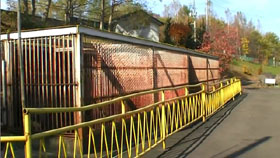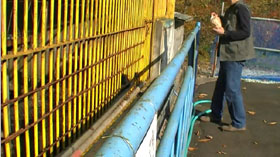What's Wrong with Hachimantai Bear Farm?
On April 20, 2012, some of the bears escaped from Hachimantai
Bear Farm in Akita Prefecture. Two female employees were
mauled to death. It was an extremely tragic event.
For a long time, this bear farm has been subject
to criticism over its treatment of bears. In fact, a meeting
was held to discuss the relevant issues attended by officials
of Akita Prefecture, representatives of the WSPA and ALIVE,
and the owner of Hachimantai Bear Farm. This meeting resulted
in a decision to close the farm and the management of the
farm was supposed to be working on finalizing the details.
However, the farm’s ownership changed during the course
of this process and due to this and several other reasons,
the farm’s status has remained unchanged. In the meantime,
the facility has become dilapidated after many years of
use and the environment in which the bears are kept has
grown progressively worse. In October 2011, ALIVE visited
the site and sent a letter to Akita Prefecture regarding
the care of the animals and the facility.
Following is the response from the prefecture
and ALIVE's suggestions regarding the further approaches.
 |
 |
| The bear cages at Hachimantai.
The facility is old, the door is not secure, and the
distance between the visitors and the bear cages is
close. Moreover, security is too poor for the keeping
of specified animals. |
1. Feeding and Care of Bears
Feeding is one of the major problems at Hachimantai
Bear Farm. Around 10 kg of leftovers from hospital meals
and 2 kg of apples and vegetables are provided every other
day per bear. This is not a suitable diet for bears to eat.
Struggles for dominance take place between
bears in overpopulated and confined places such as this
farm. Some of the bears are not eating enough. On a past
visit, we observed bears that were not even able to approach
the food because they were intimidated by stronger bears.
The farm closes in winter, but the bears are
unable to hibernate because they are too "physically
frail" to go through hibernation. There is no area
for sleeping or resting, and no roofed area. No consideration
paid at all to the bears living conditions.
2. Identification of Individual Bears
Bears are "specified animals",
according to the Act on Welfare and Management of Animals.
Any facilities that keep specified animals are required
to use microchips or some other kind of identification method.
The already closed Jyozankei Bear Farm was not complying
this requirement, and neither was Hachimantai Bear Farm.
The reason given was that "there were no veterinarians
who can implant microchips in bears." They used photos
to identify the bears instead. Another bear farm in Akita
Prefecture, Ani Bear Farm, receives help from Hokkaido University
and follows a policy of implanting microchips to identify
individual bears. Without any identification, there is no
practical way to trace an individual’s origin, date
of birth, gender, etc., at the time of arrival this makes
it impossible to manage breeding plans or to control diseases.
Facilities such as Hachimantai Bear Farm, which operates
without being subject to even basic management ethics, are
unqualified to keep 40 specified animals.
3. Receiving Asian Black Bears Captured
in a Different Prefecture
On October 26, 2010, Toyoda City in Aichi
Prefecture caught a mother bear and her two cubs. The authorities
decided that they could not release them back into the wild,
so they asked Hachimantai Bear Farm to take them. Soon after
Hachimantai Bear Farm accepted the three bears, the mother
bear died of a debilitating condition. When ALIVE researched
the incident, the farm said that the cubs would be handed
over to a hunter for the purpose of using them to obtain
bear bile and meat.
Since the public was against the culling of
these bears, Toyoda City decided to send them to Hachimantai
Bear Farm. Other municipal governments have also asked Hachimantai
Bear Farm to accept bears captured in their areas. Akita
Prefecture has repeatedly warned the bear farm not to readily
accept bears. The prefecture has also contacted the Ministry
of the Environment to inform the ministry that the frequency
of cases in which prefectures send captured bears to Hachimantai
Bear Farm is increasing.
The municipal government officers in charge
of wildlife protection lack information and knowledge about
the inhumane treatment of animals at bear farms. This was
one of the reasons why the bears handed over by Toyoda-city
ended up as victims of Hachimantai Bear Farm. The two cubs
were placed in inhumane confinement. Once bears become accustomed
to being taken care of by humans, sending them back to the
wild is virtually impossible. When animals other than targeted
animals are captured, the hunters are obliged to release
them, but the local people are usually against the release
of bears in their areas, so the municipal offices often
face challenges in choosing where to release captured bears.
4. Site Inspections of Specified
Animal Facilities
Akita Prefecture has repeatedly visited Hachimantai
Bear Farm and ordered the farm’s management to control
breeding, renovate the facility and improve the care and
management of the bears. The facility has not complied with
the order or with the law as an animal exhibition facility.
The municipal office has been having hard time supervising
the farm. One of the items included in the next management
plan was to close the bear farm. If the farm is closed,
the 40 bears housed at the facility will be neglected even
more and their status in terms of law will become that of
"specified animals, owned by an individual" and
not “exhibition animals” any longer. They can
then be expected to meet the same fate as the bears at Jyozankei
Bear Farm. (Please refer ALIVE No.101)
5. Welfare of Specified Animal
The current law does not have any section
or provisions that protect the welfare of specified animals,
while it does protect human property and assets. The amended
law should include the welfare of specified animals and
the treatment measures to be implemented in the case of
unwanted specified animals. Once these items have a legal
standing, municipal governments will be able to take more
stringent action concerning site inspection and the issuing
of necessary orders. 6. Animal Handling Businesses and Their
Responsibilities
Animal exhibition businesses are required
to register with their local prefecture. If they fail to
do so, the businesses in question can no longer continue
to operate. The Act also requires animal exhibition businesses
to employ a responsible person in charge who has the experience,
knowledge and skills to handle animals. This person in charge
is required to attend annual lectures set by the prefectures
to obtain deeper understanding about the Act on Welfare
and Management of Animals and other relevant guidelines.
The person in charge is also responsible of training her/his
juniors to comply with the rules and regulations they are
required to follow. Suspicion exists that the owner of Hachimantai
Bear Farm was not fulfilling any of these responsibilities.
The ALIVE Bear Farm Investigation Team will
continue working to improve the inhumane conditions existing
at bear farms such as Jyozankei or Hachimantai and will
keep talking with municipal governments. We appreciate your
consideration and cooperation with respect specified animals
and the improvement of their welfare.




![]()



